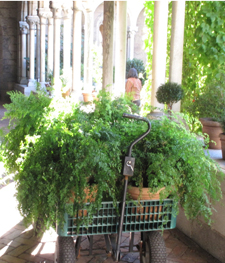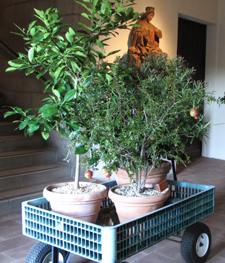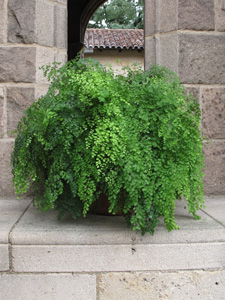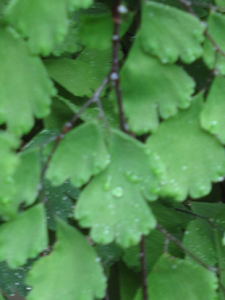Friday, October 28, 2011


Potted plants too tender to spend the winter in Bonnefont garden are trucked inside and brought up to Cuxa cloister, which is??glazed in mid-October. Mediterranean plants such as bitter orange, myrtle, and bay laurel spend the cold season in the sunny arcades and??are brought back out to the herb garden when the glass comes down in mid-April. Left:??A wagonload of maidenhair fern in the arcade of Bonnefont garden. Right:??oranges and pomegranates en route to Cuxa cloister.?? Photographs by Carly Still
While the medieval plant collection at The Cloisters includes a good number of northern European species, a great many of the plants grown in the Bonnefont Cloister herb garden are Mediterranean in origin. Not all of these southern European plants are hardy for us here in New York City. The garden is a sheltered U.S.D.A. Hardiness Zone 7, and the fig tree (Ficus carica), poet’s jasmine (Jasminum officinale), and lavender (Lavandula angustifolia) do just fine outdoors, but more tender species like bitter orange (Citrus aurantium), rosemary (Rosmarinus officinalis), bay laurel (Laurus nobilis), and dittany of Crete (Origanum dictamnus) must be brought inside and protected from the cold. Read more »
Tags: Albertus Magnus, bay, Citrus aurantium, cucumber, cucurbit, dittany, fern, ficus carica, fig, jasmine, Jasminum officinale, laurel, Laurus nobilis, Lavandula angustifolia, Lavender, maidenhair, myrtle, orange, Origanum dictamnus, rosemary, Rosmarinus officinalis, santolina, winter
Posted in Food and Beverage Plants, Fragrant Plants, Gardening at The Cloisters, Introduction, Magical Plants, Medicinal Plants, Medieval Agriculture, Plants in Medieval Art | Comments (2)
Thursday, September 8, 2011


The lovely Venus maidenhair is not quite hardy for us at The Cloisters, and is grown in pots in the medieval gardens. The pinnules of this graceful fern, which flourishes in moist and rocky situations in many parts of the world, repel water.?? Photographs by Carly Still
The southern or Venus maidenhair (Adiantum capillis-veneris)??belongs to a large genus of ferns that includes two hundred species. The botanical name given to the genus Adiantum is from the Greek for “unwetted,” since any water falling on the foliage of these ferns beads up, leaving the leaf surfaces dry. This species was??already known by that name??in classical antiquity; the Roman natural historian Pliny marveled that a plant that grew in moist places exhibited such a marked antipathy to water. According to Pliny, the plant??was known to some as “beautiful hair” or “thick hair.”?? A decoction of the fern, made by??simmering it with celery seed in wine and oil, was used both to dye the hair and to prevent it??from falling out (Historia naturalis, Book XXII, 62???65). Read more »
Tags: Adiantum, baldness, Dioscorides, fern, Hortus Sanitatis, maidenhair, Maude Grieve, pinnule, Pliny, Rufinus, Salerno, stipe, Venus
Posted in Gardening at The Cloisters, Medicinal Plants | Comments (5)




